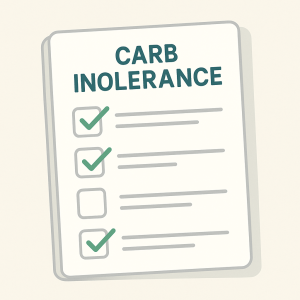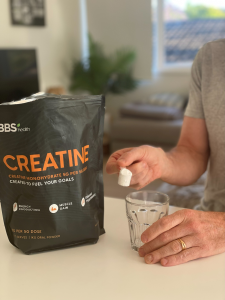-
Managing metabolic imbalance takes up a good 50% of my professional life. It’s one of the most common health challenges I see in everyday Aussies — especially those who’ve tried “every diet under the sun” and still feel stuck.
Before diving into strategies that help your body burn stored fat as a preferred fuel (a process called fat adaptation) — and before looking at key markers like HbA1c, triglycerides, uric acid, and blood pressure — I usually start with something much simpler: 👉 a short carb intolerance questionnaire.
Why? Because your daily feelings, cravings, and energy swings often tell the story well before your blood tests do.

🧠 What is Carb Intolerance? (the way I see it)
Carb intolerance isn’t an allergy or a disease — it’s your body waving the red flag that it’s struggling to handle the amount or type of carbohydrates you’re giving it.
When insulin — your key blood sugar regulator — becomes less effective over time, you can end up with:
⚡Energy highs and crashes
🍬 Unrelenting cravings (especially in the afternoon or evening)
😴 Poor sleep and low morning energy
🫤 Weight that seems to stick, no matter what you try
The good news? This can often be turned around with the right nutrition and metabolic reset. But first, it helps to understand your current pattern.
-
Two of our daughters have been using creatine loading for the best part of three years. It’s actually compulsory in their High-Performance Institute program — used to help muscle recovery, boost strength, and in their case, even slightly increase their frameset, which is a handy advantage in water polo.
So with so much chatter (and solid science) around creatine, I figured:
👉 Righto… let’s give it a proper 10-week trial.Why I Tried It
.
There’s a mountain of reputable data now showing creatine isn’t just for bodybuilders:
• Helps build and preserve muscle mass (important as we age and fight sarcopenia).
• Improves strength and exercise recovery.
• Supports brain function, including memory and mental sharpness.
I’m not chasing high-performance gains — just a bloke keeping fit, healthy, and switched on.

💊 Dosage
.
• Loading phase: 10 g morning + 10 g night for 10 days.
• Maintenance: 15 g daily for the remaining 8 weeks.
• Mixed in water — tasteless, easy, no drama.
My Usual Routine
.
I didn’t change a thing training-wise:
• Ride 🚴 4/7
• Run 🏃 3/7
• Weights 🏋️ 10–15 min most days (simple dumbbell moves + core work).
Diet stayed pretty steady too: good protein, decent fats, light on carbs, hardly any sugar… and, yep, a few beers here and there.
What I Noticed
.
• Strength bump: I started cranking out more reps or adding a bit more weight — same sets suddenly felt easy.
• Body Pod scan: +1 kg of muscle in 10 weeks. Doesn’t sound massive, but for me that’s significant.
• Leaner look: My wife reckons I look a touch leaner up top without much shape change.
• Mental sharpness: Clearer head and better focus from about 6 am to 3 pm. Hard to measure, but I could feel it.
What’s Next?
.
Like my daughters say — and the data backs it — your body adapts. Best bet is to cycle creatine.
I’ll probably run two 10-week blocks a year.
If you’re curious, do your homework — there’s a stack of good info out there on creatine loading.
“Creatine isn’t a magic pill, but it’s one of the few supplements with real bang for buck — especially as we age.”
-
If, like me, your swimming talent will prevent drowning, but see you fall short of an Olympic medal, consider these 3 technical tips from my man, Chris Fydler.
Fydes' featured in the Sydney Olympic 4 x 100m Freestyle Gold medal team with Ian Thorpe, Michael Klim & Ashley Callus. This makes him an expert. I asked Fydes' for three simple tips for punters like me.
TIP #1 - Drive and reach your leading hand as far as possible.
This will lengthen your body, helping your gliding motion. Many shortchange their stroke.
TIP # 2 - Look straight down and not up and forward.
Looking up will usually cause your heavy legs to sink deeper, making it harder to move forward. You guessed it, the black line is your marker.
TIP # 3 - Pull water back under your body (from the catch).
It is important to avoid pushing water straight down or to the side, as this can cause your body to move up and down rather than forward.
"Pampy, outside those tips, there's not much else I can do for you, I'm afraid"
-
 Three years ago, Rafal Zieja wandered up to me and asked if I knew a thing or two about half-marathon prep. Suggesting I’d been around the track once or twice (cheek!), I said I could probably help.
Three years ago, Rafal Zieja wandered up to me and asked if I knew a thing or two about half-marathon prep. Suggesting I’d been around the track once or twice (cheek!), I said I could probably help.Raf wasn’t starting from scratch. Fit as a fiddle, cycling and running were already his thing. He eats clean, trains smart, and even produces what I reckon is the best honey on the East Coast. But running a full marathon is a different beast altogether. Here’s the step-by-step approach we used to get him marathon-ready and across the line in Sydney.
1. Feet First
Forget cardio for now — we start at ground level. Strong feet mean resilient runners. Raf did progressive barefoot shuffles on soft grass, nice and easy. When the soles tingled at the end, we knew they were waking up.
2. Lower Legs of Steel
Every stride loads the calves and achilles with up to eight times your body weight. Without strength here, injuries are inevitable. So, easy hill repeats became his bread and butter. Short strides up and — critically — down. Over-striding is the fast track to knee trouble.
3. Running Tall
Once the feet and legs were dialled in, it was time to sharpen technique. Shoulders back and down, hips tall, land quietly under the hips, lift the foot smoothly. We ran flat repeats at easy effort until posture became second nature — it has to hold when the pressure comes on.
4. Time on Feet
Mileage now. Gradual build, about 10% extra per week for 6–8 weeks. No sudden jumps, no hero stuff. All at “DTI pace” — a steady effort you could hold all day. Comfortable, not crushing.
5. Now, and Only Now, Fitness
With strength and technique in place, we pushed the pace. Interval work on flats, some grass sessions, always measured with the clock. The goal: quicker legs that could handle the tempo without falling apart.
6. Dress Rehearsal
Three weeks out, we ran a mock marathon. Full fuelling plan — gels, water, salts, the works. Same pacing, same rhythm. This session builds belief, the secret weapon when the marathon demons arrive at the 75% mark. And they always arrive.

7. Race Day
Sydney Marathon. I told Raf: “Hold back the first 5km. Everyone blows up early. Don’t.” He listened. Ran smooth, saved his matches, and when the demons showed up (right on schedule), he had the legs and the belief to push through. Result? A personal best marathon — at 51 years old!
He loved it, finished strongly, injury-free, and now, in true Raf style, is eyeing off a 160km trail run. That’s where I step aside — he’s got the strength, the know-how, and the stubborn streak to take it from here.
Good luck, Raf!

